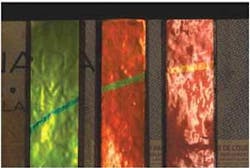Pressure-activated photonic crystals provide anticounterfeit capability
Engineers at Opalux (Toronto, ON, Canada) have developed a technology platform that exploits the properties of electrically, mechanically, or optically stimulated photonic crystals to create materials used in a variety of illumination, signage, anticounterfeiting, and other applications.
One of the company’s main product lines, Elast-Ink, combines photonic-crystal materials with synthetic rubbers. When stretched, squeezed, or twisted, the shape changes induce physical changes to the crystalline structure and periodicity of the embedded photonic-crystal materials, producing external color changes that are impossible to forge. For example, a patch of red Elast-Ink material could be coated onto a product package, banknote, or other secure document. By simply squeezing this patch between one’s fingers or scratching a fingernail across it, the end user would cause the patch to change color, or even to display data or graphics, providing a proof of authenticity. Contact Andre Arsenault at [email protected].
